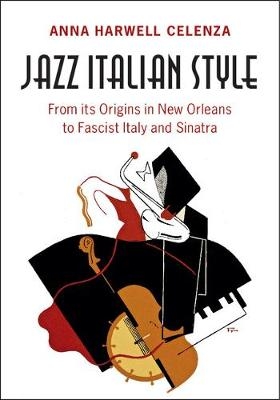
Jazz Italian Style
From its Origins in New Orleans to Fascist Italy and Sinatra
Seiten
2017
Cambridge University Press (Verlag)
978-1-107-16977-7 (ISBN)
Cambridge University Press (Verlag)
978-1-107-16977-7 (ISBN)
By examining politics, immigration patterns, economics and technology in explaining the largely forgotten Italian connection to jazz, the book will attract readers interested in music history, Italian-American culture, the Fascist era in Italy, music technology, and the evolution of popular music.
Jazz Italian Style explores a complex era in music history, when politics and popular culture collided with national identity and technology. When jazz arrived in Italy at the conclusion of World War I, it quickly became part of the local music culture. In Italy, thanks to the gramophone and radio, many Italian listeners paid little attention to a performer's national and ethnic identity. Nick LaRocca (Italian-American), Gorni Kramer (Italian), the Trio Lescano (Jewish-Dutch), and Louis Armstrong (African-American), to name a few, all found equal footing in the Italian soundscape. The book reveals how Italians made jazz their own, and how, by the mid-1930s, a genre of jazz distinguishable from American varieties and supported by Mussolini began to flourish in northern Italy and in its turn influenced Italian-American musicians. Most importantly, the book recovers a lost repertoire and an array of musicians whose stories and performances are compelling and well worth remembering.
Jazz Italian Style explores a complex era in music history, when politics and popular culture collided with national identity and technology. When jazz arrived in Italy at the conclusion of World War I, it quickly became part of the local music culture. In Italy, thanks to the gramophone and radio, many Italian listeners paid little attention to a performer's national and ethnic identity. Nick LaRocca (Italian-American), Gorni Kramer (Italian), the Trio Lescano (Jewish-Dutch), and Louis Armstrong (African-American), to name a few, all found equal footing in the Italian soundscape. The book reveals how Italians made jazz their own, and how, by the mid-1930s, a genre of jazz distinguishable from American varieties and supported by Mussolini began to flourish in northern Italy and in its turn influenced Italian-American musicians. Most importantly, the book recovers a lost repertoire and an array of musicians whose stories and performances are compelling and well worth remembering.
Anna Harwell Celenza is the Thomas E. Caestecker Professor of Music at Georgetown University, Washington DC, where she teaches courses in music history, radio journalism and the music industry. She is the author or editor of several scholarly books, and has published numerous articles on composers and musicians from Franz Liszt and Gustav Mahler to Duke Ellington, Billy Strayhorn, Louis Armstrong and Frank Sinatra.
1. Italians and the origins of jazz; 2. Jazz crosses the Atlantic; 3. Jazz and fascism; 4. Jazz Italian style; 5. A nation divided.
| Erscheinungsdatum | 28.03.2017 |
|---|---|
| Zusatzinfo | 12 Halftones, black and white |
| Verlagsort | Cambridge |
| Sprache | englisch |
| Maße | 183 x 254 mm |
| Gewicht | 640 g |
| Themenwelt | Kunst / Musik / Theater ► Musik ► Jazz / Blues |
| Kunst / Musik / Theater ► Musik ► Klassik / Oper / Musical | |
| Geschichte ► Teilgebiete der Geschichte ► Kulturgeschichte | |
| Sozialwissenschaften ► Politik / Verwaltung ► Politische Systeme | |
| Sozialwissenschaften ► Politik / Verwaltung ► Politische Theorie | |
| ISBN-10 | 1-107-16977-1 / 1107169771 |
| ISBN-13 | 978-1-107-16977-7 / 9781107169777 |
| Zustand | Neuware |
| Haben Sie eine Frage zum Produkt? |
Mehr entdecken
aus dem Bereich
aus dem Bereich
der stille Abschied vom bäuerlichen Leben in Deutschland
Buch | Hardcover (2023)
C.H.Beck (Verlag)
CHF 32,15
vom Mittelalter bis zur Gegenwart
Buch | Softcover (2024)
C.H.Beck (Verlag)
CHF 16,80
Die Revolution des Gemeinen Mannes
Buch | Softcover (2024)
C.H.Beck (Verlag)
CHF 16,80


